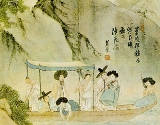
Saenghwang
Encyclopedia

Korea
Korea ) is an East Asian geographic region that is currently divided into two separate sovereign states — North Korea and South Korea. Located on the Korean Peninsula, Korea is bordered by the People's Republic of China to the northwest, Russia to the northeast, and is separated from Japan to the...
n wind instrument. It is a free reed mouth organ derived from (and quite similar to) the Chinese sheng
Sheng (instrument)
The Chinese sheng is a mouth-blown free reed instrument consisting of vertical pipes.Traditionally, the sheng has been used as an accompaniment instrument for solo suona or dizi performances. It is one of the main instruments in kunqu and some other forms of Chinese opera...
, though its tuning is different.
It is constructed from 17 bamboo pipes, each with a metal free reed, mounted vertically in a windchest. Traditionally the saenghwang's windchest was made out of a dried gourd but nowadays it is more commonly made of metal or wood. In contrast to other Korean traditional instruments, it is not well known today, even in Korea, and very few musicians are able to play it. It is used primarily in chamber music, usually in combination with instruments such as the danso
Danso
The danso is a Korean notched, end-blown vertical bamboo flute used in Korean folk music. It is traditionally made of bamboo, but in the 20th century it has also been made of plastic....
(vertical flute) and yanggeum
Yanggeum
The yanggeum is a traditional Korean string instrument. It is a hammered dulcimer. Unlike other traditional Korean instruments , the yanggeum has metal strings. It is played by striking the strings with a bamboo stick....
(hammered dulcimer) although bands such as Arirang Frontier and Orgasm (오르가슴) have been known to employ it in a fusion setting. The instrument was referred to historically as saeng .

External links
- Saenghwang page
- Saenghwang page (with audio sample)
- Painting and poem describing saenghwang

